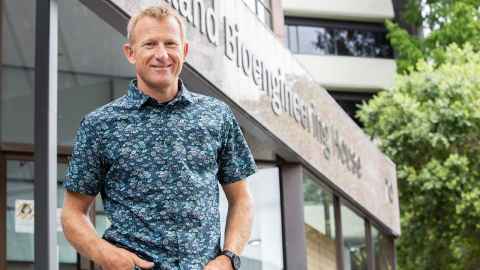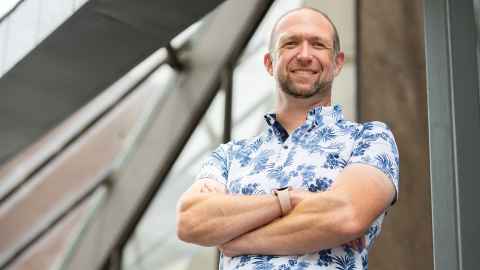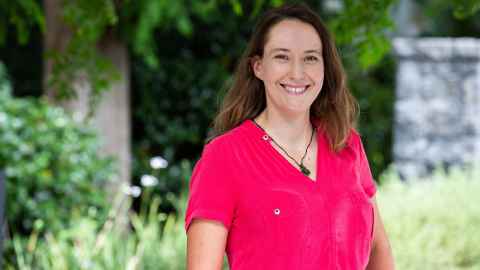Friedlander Foundation funds ABI movement disorders project
6 April 2022
Around one in every 500 babies in New Zealand is born with asphyxiation and stroke and suffers some degree of brain damage.

Unfortunately the signs of damage, which are usually grouped under the heading “Cerebral Palsy”, are not always visible from birth and not identified or diagnosed until the infant is much older.
This means an important opportunity to intervene with tools and strategies that could greatly reduce the burden of the disability, is missed.
Now groundbreaking research funded by The Friedlander Foundation at the Auckland Bioengineering Institute (ABI) is set to change this.
The Foundation has given $2.95 million for a five-year project focused on developing tools for early detection and treatment of neurological disorders in infants. Professor Thor Besier, who runs ABI’s musculoskeletal modelling group and his co-investigator, Dr Angus McMorland from the University’s Department of Exercise Sciences, are leading a team of 16 researchers.
“Creating tools to assess and treat children with neurological disorders will have an enormous impact on the lives of those affected,” says Thor. “It also has the potential to reduce the associated costs of healthcare and give equality to all New Zealand babies.”
About 10,000 children in New Zealand currently have Cerebral Palsy (CP) affecting their body’s ability to perform controlled movements such as eating, speaking, breathing, bladder and bowel control. CP is not a progressive neural disease – the lesions that cause the disease are static – yet paradoxically the musculoskeletal systems of children worsen over time.
Jillian Friedlander knows the impact of neurological disorders better than most. When she gave birth to twin girls 18 years ago in 2003, Maia suffered a stroke and oxygen deprivation at birth. The family took Maia, aged four, to the Duke University Children’s Hospital and Health Centre in the USA and under Dr. Joanne Kurtzberg, she became the first child from Australasia and 51st child to be treated using stem cells from her own umbilical-cord blood. The impact on her movement was almost immediate.
Now that Maia is 18, CT and MRI scans show she has a normal functioning brain from the stem-cell transplant. But she still has movement issues – teenagers grow, they lose balance and it’s much harder for Maia to regain that control of movement.
Early in 2022 Maia will pioneer novel gait-retraining technology that has been developed at ABI and could help to improve her walking patterns.
“We chose to support the ABI work to benefit not only our daughter but for all future parents who go through the crisis of stroke and CP in New Zealand,” says Jillian.
“We were looking to make an impact,” she adds. “Stroke is now the most common cause of permanent disability for New Zealanders and Cerebral Palsy (CP) is the most common neurological disorder affecting children.”
The ABI project spans four fronts. The first is developing a novel, camera-based system to detect movement disorders in infants.
Dr Angus McMorland, an expert in motor control and neuroscience, is leading this work. His team is well on the way to refining automatic analysis of videos of babies’ movements. He hopes parents will eventually be able to use a simple mobile phone app to record these movements themselves at home and then have the video automatically analysed to look for risk signs of CP and stroke.

In the second part of Angus’s work, his team is feeding meticulously labelled videos and clinical assessment data into very large computer-learning systems, which will then create complex algorithms for assessing movement.
“We are training the computers, for example, to be able to look at a baby’s foot or elbow and how they move and then decide from those movement patterns, whether any abnormality is likely to appear, even two years down the track.
“At the moment we know that about 55 percent of children that develop movement disorders are probably already seen as high risk because of being born premature or because of problems at birth. For the other 45 percent of children that go on to develop neurological injuries, there are no early warning signs that would lead us to do follow up tests. This means these babies sometimes don’t get identified until they are two years of age, by which time the phases of musculoskeletal development have been impacted.
“We hope with our work, there will be subtle movement indications to identify these non-obvious cases.”

Working alongside Angus and Thor is Dr Julie Choisne, a research fellow at the ABI and an expert in computational modeling. Julie is leading a team that is creating a paediatric anatomical atlas of the musculoskeletal system.
“Until now it has been assumed we can just take adult models and scale them down for children. But there are a lot of changes in bone shape as children get older, depending on their age, height, mass and sex, if they have deformities or not.”
Using a statistical cohort of 300 CT scans of deceased children aged 4 to 18 from the Victoria Institute of Forensic Medicine in Melbourne, Julie’s team is building the world’s first comprehensive atlas of paediatric bone growth.
“We are seeing changes in children we have never seen before.”
As a result of the atlas work, researchers will soon be able to use huge data sets to understand normal or abnormal bone growth and create patient-specific, paediatric anatomical models.
From these, web-based software will be designed for clinicians so they can quickly develop a personalised assessment of a child’s movements.
One of the challenges of children with neurological disorders is the unusual deformation of bones. Even though signals sent from the child’s brain to its limbs can be retrained, most children still need additional help to move.
With the Friedlander funding, ABI has purchased a state-of-the-art, Alter-G gait-retraining treadmill that uses an inflatable “bladder” to push the user off the ground so they experience less body weight when walking or running on the treadmill. Clinical trials, which Maia Friedlander will be a part of, have been designed to assess the benefits of this. Maia has already been in and met the team scheduled to start the trials in 2022.
Thor Besier’s musculoskeletal modelling group are also developing low-cost wearable sensors that can be sent to different parts of New Zealand to provide remote movement assessment and monitoring for individual children.
“If we can create models specific to each child and their biomechanics then this work will be game-changing for paediatrics,” says Thor.
For Jillian Friedlander the opportunity for a personalised medicine model “is a paradigm shift for the future. The current one-size-fits-all approach to rehabilitation clearly does not lead to optimal outcomes”.
The Friedlander-funded research is one of many groundbreaking projects underway at the Auckland Bioengineering Institute, which turned 20 in 2021. World-renowned for its mathematical modelling of various organ systems, the Institute attracts significant support from government and private donors such as Aotearoa Foundation, which is also funding part of Julie’s Choisne’s research and her salary.
The impact of donor support is huge and for Thor Besier, The Friedlander Foundation’s support in other ways, such as connecting researchers to Whānau Āwhina Plunket (NZ Plunket), has created the ideal partnership.
“We hope we can give back,” he says, “and change the lives of hundreds of young New Zealand children, and thousands worldwide, who suffer from a movement disorder.”
Media contact
Helen Borne | Communications Manager
Alumni Relations and Development
Email: h.borne@auckland.ac.nz